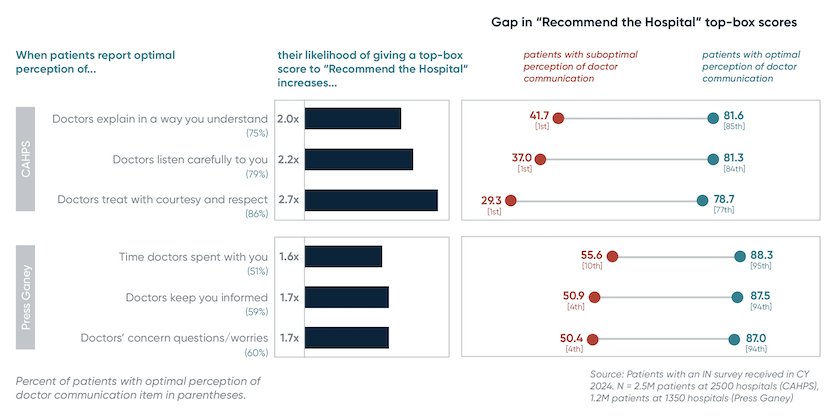Patient experience 2025: New trends and behaviors
In healthcare's evolving landscape, one currency matters more than ever: trust. As patients navigate increasingly complex care journeys, their expectations are rising—not just for clinical excellence, but for human connection, safety, and equity.
Our “Patient experience 2025” report reveals how leading organizations are closing performance gaps, building social capital, and advancing experience as a high reliability discipline. The good news is, all our hard work is, in fact, working. Across inpatient units, medical practices, emergency departments, and ambulatory surgery centers, patient experience (PX) scores are climbing. It’s a clear sign that our commitment to compassionate, connected care is making a real and meaningful difference. And yet, there’s still much to be done.
Safety is the first pillar of patient experience
Now more than ever before, patient experience starts with safety. When patients feel less than very safe, we see trust, as measured by their likelihood of recommending, drop alarmingly. Patients who report high perceptions of safety in the hospital rate "Likelihood to Recommend” (LTR) at 85.3—compared to a more than 50 mean score drop to 34.6 for anything less than a top-box response. In medical practices, this gap is even more stark.
CMS has recognized that our patients play an important role in the design and delivery of safe care. That’s why they’ve made patient and family involvement one of five key components of the 2025 Patient Safety Structural Measures.
The power of teamwork and social capital
Notably, teamwork—now a recognized metric in HCAHPS—has emerged as a primary driver of PX and trust. When patients can see our teamwork in action, and serving them, trust builds. Patients consistently say that “teams working together to care for me” is a key driver in emergency, medical practice, ambulatory surgery, and urgent care. Why is teamwork so important? When we don’t work together, it’s the patient who ends up burdened with the work of communication, coordination and ensuring their care is complete and safe.
This is one of the main reasons I say there’s no patient experience without the employee experience. Our patients’ experience is a lagging indicator of healthy teams. Patients don’t just need us to be individually committed, but they need us to organize with our colleagues and other departments to deliver coordinated care.

Different patients have different needs and experiences
Not everyone is benefiting from patient experience gains. It’s no longer enough to look at overall performance. Improvement requires segmenting the data to see who is being left behind.
We see persistent gaps across care journey, race, and age. In the inpatient setting, the largest group of patients with unmet needs are those who did not plan to be in the hospital—which is the vast majority of patients. It’s not that they need more, it’s that they need different. We need to design care to address their specific fears, concerns, and care pathways.
And we can do it. Hospitals with the smallest PX disparities between racial and ethnic groups are nearly 3x more likely to be top performers on LTR—a compelling case for equity as a strategic imperative.
Segmenting the data shows:
- Older adults (age 80+) are more likely to feel unsafe and misunderstood when managing their health.
- Black/African American and Asian patients report significantly lower safety perceptions.
- Unplanned admissions yield 16% lower LTR scores than planned ones—highlighting the need for communication and continuity in moments of uncertainty.
The great news is that across the board, use of the evidence-based nursing communication bundle can create the communication processes that allow care to be customized around patient needs. If you’ve been waiting for a compelling reason to take your rounding initiatives to the next level, look no further. Without doubt, these processes are the path to reducing disparities in care, across care journey, age, race, or other population-level needs.
Download “Patient experience 2025” to unlock all of our findings. For those ready to dive deeper, connect with the Press Ganey team and explore how to personalize these insights to your organization’s unique journey.